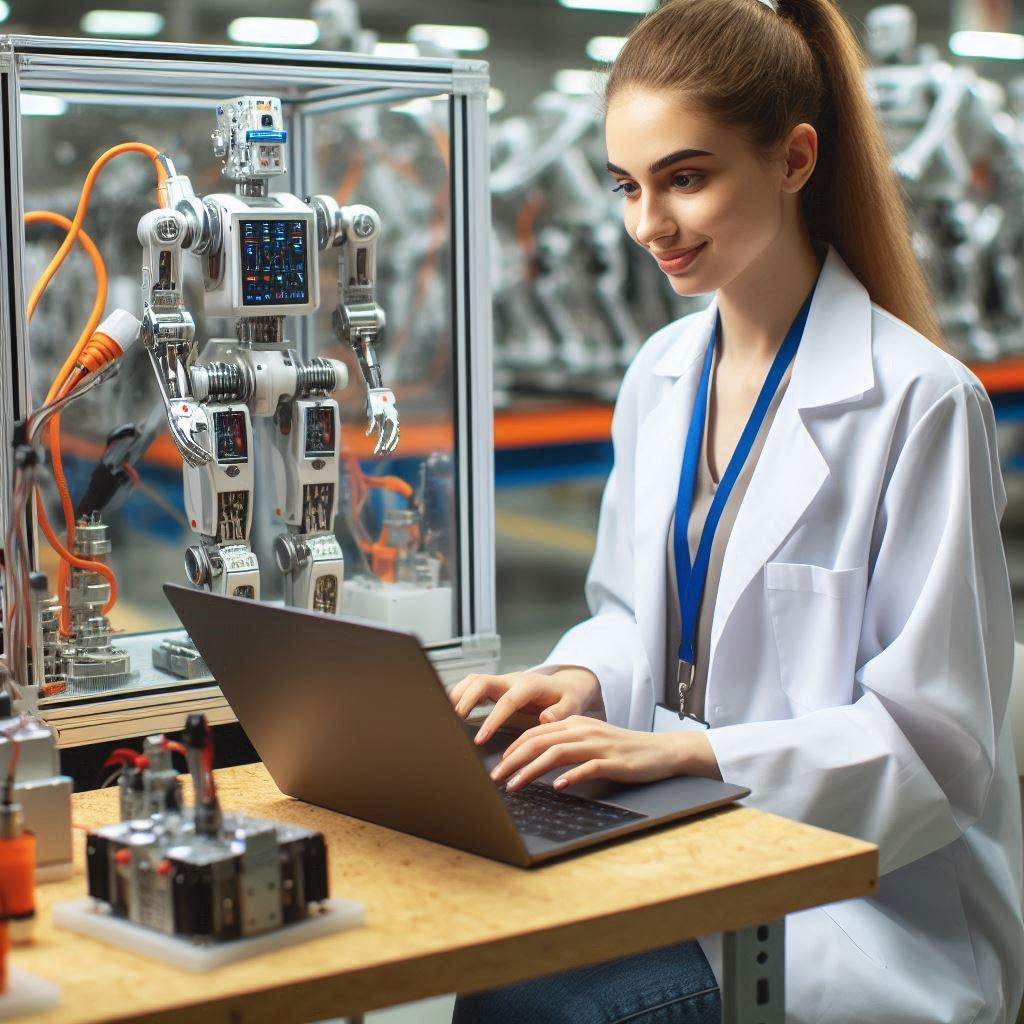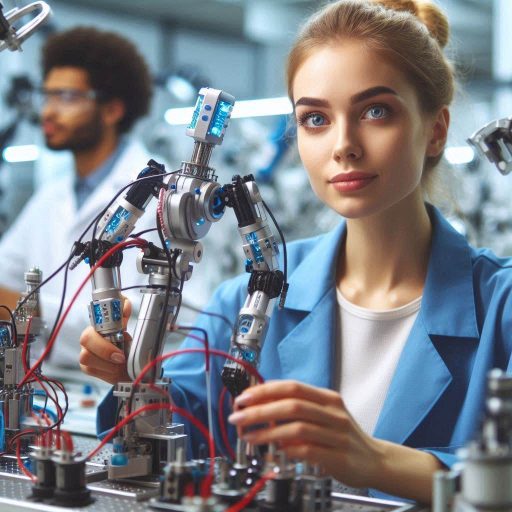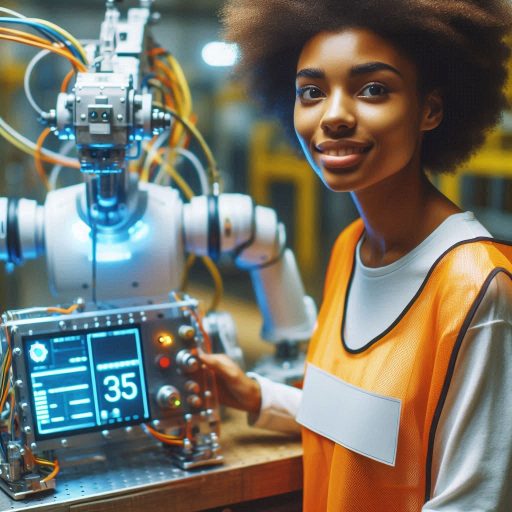Introduction
Robotics engineering and artificial intelligence (AI) are foundational to many modern advancements in technology and society.
Robotics engineering involves the design, construction, and operation of robots.
It focuses on creating machines that can perform specific tasks, from simple repetitive actions to complex manipulations.
Artificial intelligence, on the other hand, is the field of computer science dedicated to creating systems capable of learning, reasoning, and making decisions.
The synergy between robotics engineering and AI is transforming industries and enhancing daily life.
Robotics provides the physical systems that perform tasks and interact with the environment.
These systems can range from industrial robots in manufacturing to autonomous robots used in healthcare and home automation.
AI enhances these robots by enabling them to learn from data, make decisions, and adapt to new situations without human intervention.
AI algorithms process vast amounts of data to train robots, enabling them to perform tasks with increasing autonomy and precision.
For instance, in autonomous vehicles, AI algorithms interpret data from sensors to navigate roads and avoid obstacles.
History of Robotics Engineering and Artificial Intelligence
Origins of Robotics Engineering and Artificial Intelligence
Robotics engineering and artificial intelligence (AI) both have fascinating historical origins that trace back centuries.
Robotics engineering began with early mechanical devices and automata from ancient civilizations.
For instance, ancient Greeks created mechanical birds, and medieval inventors built intricate automaton figures.
These early creations demonstrated basic principles of robotics long before the term was coined.
Modern robotics engineering emerged in the mid-20th century, thanks to pioneers like George Devol and Joseph Engelberger.
They developed the first programmable robot, Unimate, in the 1960s, which transformed manufacturing by introducing automation.
Artificial intelligence also has deep historical roots.
The idea of intelligent machines can be traced back to ancient myths and philosophical debates.
The formal field of AI research began in the 1950s.
Alan Turing’s work on machine learning and the Turing Test posed questions about machine intelligence.
John McCarthy, who coined the term “artificial intelligence,” organized the Dartmouth Conference in 1956.
This event marked the official start of AI as a scientific discipline.
How These Fields Have Evolved Over Time and Their Impact on Various Industries
Over time, both robotics engineering and AI have evolved dramatically, driven by technological advancements and increasing computational power.
In robotics, early systems were limited to simple, repetitive tasks.
Modern robots, however, are equipped with advanced sensors and control systems that allow them to perform complex operations with precision.
Innovations in materials science, computer vision, and machine learning have further enhanced their capabilities, enabling robots to handle tasks from delicate assembly to intricate surgery.
AI has progressed from early symbolic AI, which relied on predefined rules, to more sophisticated machine learning and deep learning techniques.
Machine learning algorithms can analyze large datasets to detect patterns and make predictions.
Deep learning, utilizing neural networks, has enabled breakthroughs in areas such as image and speech recognition.
These advancements have expanded AI applications across various domains.
The impact of robotics and AI on industries is profound.
In manufacturing, robotics has revolutionized production lines with increased efficiency, precision, and safety.
Robots now perform tasks such as welding, assembly, and quality control, significantly enhancing operational capabilities.
In healthcare, robotic systems assist in complex surgeries, rehabilitation, and patient care, improving outcomes and efficiency.
AI’s influence is equally significant across different sectors.
In finance, AI algorithms analyze market trends and execute trades with speed and accuracy.
In retail, AI enhances customer experiences through personalized recommendations and automated services.
Autonomous vehicles, powered by AI, promise to revolutionize transportation by improving safety and operational efficiency.
Read: Environmental Engineering Software and Tools
Applications of Robotics Engineering and Artificial Intelligence
Different Industries Where Robotics Engineering and Artificial Intelligence Are Being Used
The synergy between robotics engineering and artificial intelligence (AI) is transforming various industries, enhancing capabilities and efficiency.
This integration is revolutionizing sectors like manufacturing, healthcare, agriculture, logistics, retail, and research.
Each industry leverages the combined strengths of robotics and AI to address complex challenges and improve operations.
In manufacturing, robotics and AI collaborate to optimize production.
For example, Tesla’s AI-powered robots handle tasks like welding, painting, and assembly.
These robots adapt in real-time, improving precision and reducing production times.
Healthcare benefits from AI and robotics through advancements like the da Vinci Surgical System.
This surgical robot uses AI for real-time data analysis and enhanced visualization.
It results in more accurate surgeries and quicker recoveries.
Additionally, AI-powered rehabilitation robots offer personalized therapy, aiding patient recovery.
Agriculture sees increased efficiency with AI and robotics.
Autonomous tractors and drones analyze soil and crop health.
Robots like Harvest CROO identify and pick ripe strawberries efficiently.
This technology reduces labor costs, optimizes resources, and boosts crop yields.
In logistics, AI and robotics advance automation.
Automated guided vehicles (AGVs) and robotic systems manage inventory and sorting.
Amazon’s robots move goods and streamline order fulfillment in fulfillment centers, enhancing efficiency and accuracy.
Retail also benefits from these technologies.
Automated checkout systems and customer service robots improve the shopping experience.
Robots in grocery stores assist customers, while AI-driven checkouts speed up transactions and minimize errors.
In research, robots equipped with AI conduct experiments and gather data in challenging environments.
AI allows these robots to adapt and perform complex operations autonomously.
Examples of How These Technologies Are Being Applied in Real-Life Situations
In real-life situations, the application of robotics and AI is transforming industries.
In manufacturing, Tesla’s use of AI-powered robots has revolutionized vehicle assembly.
These robots adapt to various tasks, ensuring high precision and efficiency.
In healthcare, the da Vinci Surgical System demonstrates how AI enhances surgical precision.
This robotic system assists surgeons by providing detailed visualization and real-time data, improving patient outcomes.
In agriculture, the Harvest CROO robot showcases the application of AI in harvesting.
This robot uses AI to identify and pick ripe strawberries, increasing harvest efficiency and reducing labor costs.
Amazon’s use of AI-driven robots in its fulfillment centers highlights the impact on logistics.
These robots manage inventory and streamline the sorting process, leading to faster and more accurate order fulfillment.
In retail, automated checkout systems and customer service robots improve the shopping experience.
Robots in grocery stores assist with product location and customer inquiries, while AI-powered checkout systems speed up transactions.
In research, robots equipped with AI conduct experiments and explore environments that are challenging for humans.
These robots contribute to advancements in various scientific fields by performing complex tasks autonomously.
Read: How to Stay Updated in Environmental Engineering Field
Advantages of Synergy between Robotics Engineering and Artificial Intelligence
Combining Robotics Engineering and Artificial Intelligence
Combining robotics engineering with artificial intelligence (AI) creates powerful and efficient systems.
Robotics provides the hardware foundation, while AI adds advanced capabilities to process and analyze data.
Together, they enable robots to perform complex tasks with greater autonomy and precision.
AI algorithms can enhance a robot’s ability to learn from its environment and adapt to new situations.
This synergy allows robots to make real-time decisions, handle unstructured tasks, and improve their performance over time.
Benefits of Synergy in Terms of Cost Savings
The integration of AI into robotics leads to significant cost savings.
Intelligent robots can automate repetitive and complex tasks, reducing the need for human labor.
By minimizing human intervention, companies lower labor costs and reduce the likelihood of errors.
AI-driven robots can also perform predictive maintenance, identifying potential issues before they cause breakdowns.
This proactive approach prevents costly repairs and downtime, further driving cost efficiency.
Over time, the initial investment in AI-enhanced robotics pays off through reduced operational expenses and increased reliability.
Benefits of Synergy in Terms of Productivity
AI and robotics together boost productivity in various industries.
AI enables robots to operate more efficiently by optimizing their movements and tasks.
Robots equipped with AI can work faster and more accurately than their human counterparts.
They can perform continuous operations without fatigue, increasing overall output.
Intelligent systems can also manage and coordinate multiple robots, streamlining workflows and enhancing production rates.
The combined power of AI and robotics ensures that tasks are completed more swiftly and with higher consistency, leading to substantial productivity gains.
Benefits of Synergy in Terms of Innovation
The synergy between robotics and AI fosters innovation by pushing the boundaries of what robots can achieve.
AI algorithms allow robots to tackle complex and previously impossible tasks.
This collaboration drives new applications and technologies, leading to innovative solutions across industries.
For example, AI-powered robots can now perform intricate surgical procedures, conduct advanced research, and explore hazardous environments.
The fusion of AI and robotics accelerates technological advancement and opens up new possibilities for solving complex problems.
As these technologies evolve, they continually inspire novel applications and improvements in robotics.
In summary, combining robotics engineering with artificial intelligence creates more efficient and effective systems.
This synergy offers significant benefits, including cost savings, enhanced productivity, and a boost in innovation.
AI enhances the capabilities of robotics, making systems smarter, more reliable, and versatile.
Embracing this integration leads to groundbreaking advancements and positions companies at the forefront of technological progress.
Read: Environmental Engineering and Corporate Social Responsibility

Challenges and Ethical Considerations
Potential Challenges and Ethical Dilemmas
One major challenge is ensuring the safety of AI-driven robots.
As robots become more autonomous, the risk of malfunctions or unintended actions increases.
These issues can lead to accidents or injuries, particularly in environments where robots interact with humans.
Ensuring robust safety protocols and fail-safes is essential to mitigate these risks.
Another ethical dilemma involves decision-making by AI systems.
Robots equipped with AI can make decisions based on algorithms, but these decisions might not always align with human values.
For instance, an AI in a self-driving car might face ethical choices, such as prioritizing the safety of passengers over pedestrians.
Developing ethical guidelines and decision frameworks for AI systems is critical to address such dilemmas.
Data privacy is also a significant concern.
AI systems in robotics often collect and analyze vast amounts of data, including personal information.
Ensuring that this data is handled securely and with respect for privacy is essential.
Unauthorized access or misuse of data can have serious consequences, making data protection a priority.
The potential for job displacement due to AI and robotics integration is another concern.
As robots and AI systems automate tasks, they can lead to job losses in various sectors.
Addressing this issue involves finding a balance between technological advancement and the workforce’s needs.
Providing retraining and support for affected workers is crucial.
Importance of Regulating These Technologies
Regulating robotics and AI technologies is vital to address the challenges and ethical dilemmas they present.
Establishing clear regulations ensures that these technologies are developed and used responsibly.
Regulations can set standards for safety, data protection, and ethical decision-making, guiding developers and users in implementing best practices.
Regulatory frameworks should also involve collaboration between policymakers, industry leaders, and researchers.
This collaborative approach helps create comprehensive regulations that address the complexities of AI and robotics.
Continuous updates to regulations are necessary as technologies evolve, ensuring that they remain relevant and effective.
Promoting transparency in AI systems is another important aspect of regulation.
Transparent algorithms and decision-making processes allow for better understanding and accountability.
This transparency helps build public trust and ensures that AI systems are used ethically and responsibly.
Essentially, while the synergy between robotics engineering and AI offers significant benefits, it also presents challenges and ethical dilemmas.
Addressing these issues through effective regulation is crucial to ensuring that these technologies are developed and used responsibly.
By implementing robust regulations and fostering transparency, we can harness the full potential of robotics and AI while minimizing risks and ethical concerns.
Read: The Future of Environmental Engineering Jobs
Future Trends in Robotics Engineering and Artificial Intelligence
How Robotics Engineering and Artificial Intelligence Will Continue to Evolve
The fields of robotics engineering and artificial intelligence (AI) are on a trajectory of rapid evolution.
As AI technology advances, robots will become increasingly capable of performing complex tasks autonomously.
Future robotics will likely integrate more sophisticated AI algorithms, allowing machines to make real-time decisions without human intervention.
This autonomy will enhance robots’ efficiency and adaptability across various applications, from industrial automation to personal assistance.
Machine learning models will drive robots to learn and adapt based on their experiences.
Enhanced natural language processing (NLP) will enable robots to better understand and respond to human commands, facilitating more intuitive interactions.
As AI continues to improve, robots will gain the ability to handle more nuanced tasks and work seamlessly alongside humans in diverse environments.
Potential Advancements and Breakthroughs
Several advancements and breakthroughs are on the horizon for robotics and AI.
One significant area of development is computer vision.
Future breakthroughs in computer vision will enable robots to perceive and interpret their surroundings with greater precision.
Advanced sensors and AI-driven vision systems will allow robots to navigate complex environments, identify objects, and perform tasks with increased accuracy.
This capability will revolutionize industries like manufacturing, healthcare, and logistics, where precision and adaptability are crucial.
Collaborative robots, or cobots, will see significant advancements as well.
AI-driven improvements will make cobots more intuitive and safer, enhancing their ability to work alongside humans in a wide range of settings.
These robots will become more adept at handling dynamic and unpredictable tasks, making them valuable assets in various workplaces.
The field of soft robotics will also experience notable advancements.
Soft robots, which mimic the flexibility and adaptability of biological organisms, will benefit from AI-driven enhancements.
These robots will interact more naturally with their environments and perform delicate tasks with greater dexterity.
This could lead to breakthroughs in medical surgery, where precision and flexibility are essential.
Ethical considerations will play a crucial role in shaping the future of robotics and AI.
As robots become more autonomous, ensuring ethical development and deployment will be essential.
Transparent AI decision-making and robust safety protocols will help address ethical concerns and ensure these technologies benefit society.
Education and Career Opportunities
Educational Pathways for Robotics Engineering and AI
To pursue a career in robotics engineering and AI, start with a solid educational foundation.
Begin with a bachelor’s degree in fields like robotics, mechanical engineering, computer science, or electrical engineering.
Courses in mathematics, programming, and electronics are essential.
Many universities offer specialized programs in robotics or AI, providing targeted knowledge and skills.
Transform Your Career Today
Unlock a personalized career strategy that drives real results. Get tailored advice and a roadmap designed just for you.
Start NowFollowing a bachelor’s degree, consider pursuing a master’s degree or Ph.D. in robotics, AI, or a related field.
Advanced degrees offer deeper expertise and open doors to research and development roles.
Many graduate programs focus on interdisciplinary approaches, combining robotics and AI, and offer opportunities for hands-on projects and research.
Additionally, engage in online courses and certifications to supplement formal education.
Platforms like Coursera, edX, and Udacity offer specialized courses in AI, machine learning, and robotics.
These courses provide practical skills and up-to-date knowledge on the latest technologies and methodologies.
Job Opportunities in Robotics Engineering and AI
The integration of robotics and AI creates a wide range of career opportunities.
In robotics engineering, positions include robotics design engineer, robotics systems engineer, and automation engineer.
These roles involve designing, developing, and maintaining robotic systems used in manufacturing, healthcare, and other industries.
In AI, job titles such as machine learning engineer, AI researcher, and data scientist are prominent.
Machine learning engineers focus on developing algorithms and models that enable machines to learn from data.
AI researchers work on advancing theoretical and practical aspects of AI technologies.
Data scientists analyze large datasets to extract insights and inform AI applications.
Other job opportunities include roles in robotics and AI project management, where professionals oversee the implementation of complex systems and ensure projects meet their objectives.
Software developers in these fields create applications that leverage robotics and AI technologies.
Additionally, roles in consulting and support involve advising companies on integrating robotics and AI solutions.
The healthcare industry offers roles for medical robotics engineers, who design robots for surgical assistance and patient care.
The automotive industry employs robotics engineers for autonomous vehicle development and manufacturing automation.
In the consumer electronics sector, robotics and AI professionals work on smart home devices and interactive technologies.
Conclusion
The synergy between robotics engineering and artificial intelligence (AI) is fundamentally reshaping the technological landscape.
Robotics engineering provides the physical and mechanical capabilities necessary for building machines that can interact with the world.
Meanwhile, AI equips these robots with advanced cognitive functions, allowing them to process information, make decisions, and adapt to new situations.
This combination significantly enhances the functionality and effectiveness of robotic systems.
Integrating AI with robotics leads to smarter, more versatile robots capable of performing complex tasks autonomously.
For example, in manufacturing, AI-powered robots can adapt to changes in production processes, optimize their actions, and improve efficiency.
In healthcare, robots equipped with AI can assist in surgeries, provide patient care, and even predict health issues based on data analysis.
The potential for continued growth and innovation in these fields is vast.
As AI technology advances, it will further enhance robotic capabilities, enabling even more sophisticated applications.
Future developments might include robots that can learn from experience, collaborate more effectively with humans, and perform tasks with greater precision and autonomy.




